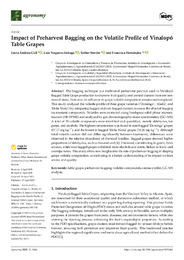Por favor, use este identificador para citar o enlazar este ítem:
https://hdl.handle.net/11000/37069Registro completo de metadatos
| Campo DC | Valor | Lengua/Idioma |
|---|---|---|
| dc.contributor.author | Andreu Coll, Lucía | - |
| dc.contributor.author | Noguera-Artiaga, Luis | - |
| dc.contributor.author | Sendra, Esther | - |
| dc.contributor.author | Hernández, Francisca | - |
| dc.contributor.other | Departamentos de la UMH::Producción Vegetal y Microbiología | es_ES |
| dc.date.accessioned | 2025-07-30T12:13:17Z | - |
| dc.date.available | 2025-07-30T12:13:17Z | - |
| dc.date.created | 2025-04-27 | - |
| dc.identifier.citation | Agronomy 2025, 15(5), 1066 | es_ES |
| dc.identifier.issn | 2073-4395 | - |
| dc.identifier.uri | https://hdl.handle.net/11000/37069 | - |
| dc.description.abstract | The bagging technique is a traditional preharvest practice used in Vinalopó Bagged Table Grape production to improve fruit quality and protect clusters from environmental stress. However, its influence on grape volatile composition remains underexplored. This study analyzed the volatile profile of three grape varieties (‘Dominga’, ‘Aledo’, and ‘Doña María’) by comparing bagged and non-bagged clusters to assess the effect of bagging on aromatic compounds. Volatiles were extracted using headspace solid-phase microextraction (HS-SPME) and analyzed by gas chromatography–mass spectrometry (GC–MS). A total of 35 volatile compounds were identified and quantified, mainly aldehydes, terpenes, and alcohols. The highest concentration was found in non-bagged ‘Dominga’ grapes (57.17 mg kg−1), and the lowest in bagged ‘Doña María’ grapes (16.36 mg kg−1). Although total volatile content did not differ significantly between treatments, differences were observed in the relative abundance of chemical families. Bagged grapes showed higher proportions of aldehydes, such as hexanal and (E)-2-hexenal, contributing to green, fresh aromas, while non-bagged grapes exhibited more alcohols and esters, linked to fruity and overripe notes. This study offers new insights into the role of preharvest bagging in shaping grape volatile composition, contributing to a better understanding of its impact on fruit aroma and quality | es_ES |
| dc.format | application/pdf | es_ES |
| dc.format.extent | 18 | es_ES |
| dc.language.iso | eng | es_ES |
| dc.publisher | MDPI | es_ES |
| dc.rights | info:eu-repo/semantics/openAccess | es_ES |
| dc.rights | Attribution-NonCommercial-NoDerivatives 4.0 Internacional | * |
| dc.rights.uri | http://creativecommons.org/licenses/by-nc-nd/4.0/ | * |
| dc.subject | Table grape | es_ES |
| dc.subject | Preharvest bagging | es_ES |
| dc.subject | Volatile compounds | es_ES |
| dc.subject | Aroma profile | es_ES |
| dc.subject | GC-MS analysis | es_ES |
| dc.title | Impact of Preharvest Bagging on the Volatile Profile of Vinalopó Table Grapes | es_ES |
| dc.type | info:eu-repo/semantics/article | es_ES |
| dc.relation.publisherversion | https://doi.org/10.3390/agronomy15051066 | es_ES |

Ver/Abrir:
agronomy-15-01066.pdf
1,09 MB
Adobe PDF
Compartir:
 La licencia se describe como: Atribución-NonComercial-NoDerivada 4.0 Internacional.
La licencia se describe como: Atribución-NonComercial-NoDerivada 4.0 Internacional.
.png)